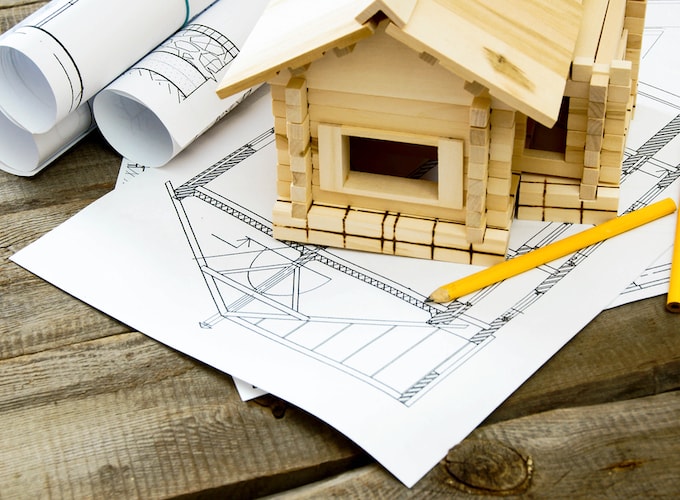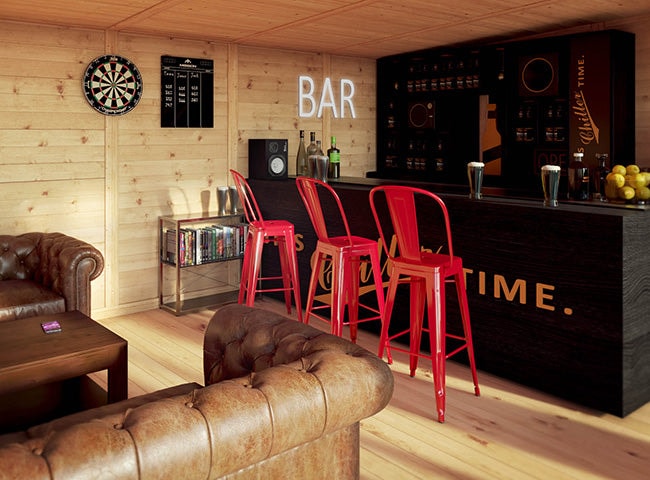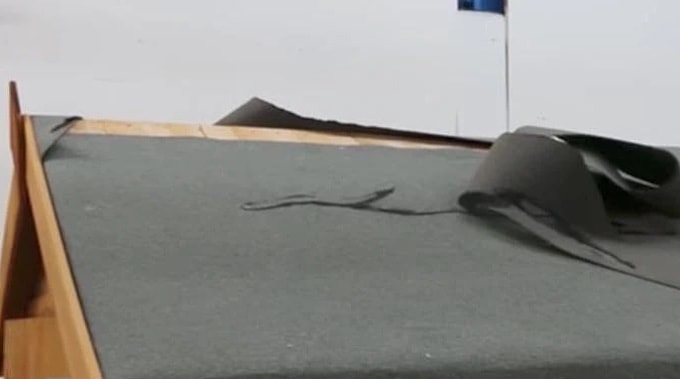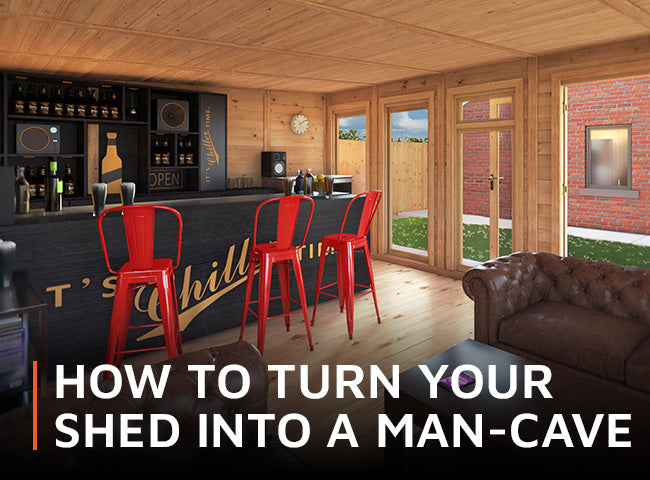Have you always wanted a space of your own? A man-cave where you can indulge your hobbies, kick back and relax with friends, and turn up the bass on your sound system? Covering everything from damp-proofing and insulation to great lighting and heating solutions, our comprehensive guide will help you plan and achieve your dream.
For a step-by-step guide to transforming a regular storage shed into something really special, follow the advice below for expert tips.
Contents:
- Decide how you want to use your man-cave
- Design the layout of your new man-cave
- Assess the current condition of your shed
- Make a list of man-cave jobs
- 11 steps to convert your shed into a man-cave
- How to convert your shed into a man-cave – quick summary
Decide how you want to use your man-cave

Image: Shutterstock
What kind of man-cave do you want? Start the process by listing all the things you’d like to do in your new man-cave, and a secondary list of all the ‘requirements’ that result. For example, if you plan to use your man cave as a gaming room, then that will require that your shed has mains electricity, a reliable internet connection and space for your gear. If you want to use it as a gym, it will require a concrete base, ventilation and anti-fatigue mats on the floor. Here are some things to consider:
- Furniture, storage, and accessories: If you want your man-cave to be a space to relax with a few drinks and some friends, you’ll need enough seating and a fridge to keep the beers cold. Maybe even a fully-stocked bar area. If the man cave will be your fortress of solitude, what kind of seating do you want? A recliner, hammock, armchair or sofa? Planning to screen movies? If you’re considering a projector, then you’ll need an unobstructed wall to accommodate a screen. But if you plan on a flat screen TV instead, will you mount it on the wall, or keep it in an entertainment centre? Dream big at this stage. Write down everything you might want in your ideal man-cave. The time for trimming the list down may come later on when you’re finalising the layout.
- Utilities: Electricity, heating and internet access are likely to be man-cave essentials. You’ll need to dig a trench at least 50cm deep to accommodate any electric cables. Check your requirements list to determine how many power sockets you will need. Account for all heaters and freestanding lamps you might use, as well as your TV, stereo, console and other appliances. What kind of light will your man-cave need? Would you be happy with the light from a few lamps and the odd neon sign? Or do you need overheads for your hobby work? Do you want the man-cave to be self-contained, with its own plumbed-in bathroom? How significant are your internet needs? Does your TV or gaming console require broadband or will tethering your laptop to your mobile suffice?
- Design: A wooden shed will allow you to create a man-cave to suit your own requirements, including adding doors, windows, and wiring it for heating, electricity and internet. You can also thoroughly insulate and weather-proof it, ensuring your man cave’s longevity. Wooden sheds have different types of exterior, namely overlap or tongue and groove cladding. Although overlap is usually cheaper, tongue and groove models are more robust and weatherproof. Apex sheds give you more internal headroom, while modern pent roofs look better in smaller gardens. If you’re moving in large furniture like a pool table or sofa, opt for double doors. See our full range of wooden sheds for inspiration.
- Base: The type of base suitable for your shed depends largely on its size, and the weight of the furniture and kit you plan to store in it. Larger sheds, and sheds with heavy contents (like gym equipment) require a solid, concrete base. But if your shed is smaller/lighter weight, a paving slab base may suffice. It’s cheaper, and easier to install (and later remove, if necessary). But be realistic about the size and weight of your shed; a paving slab base can sink over time, particularly if overloaded.
- Position: If you’re buying a new shed rather than converting an existing one - where do you have room? When working this out, add at least two more inches to the size of your shed. You will need this space when digging out for the base. Decide how close you want it to be to the main house. Although it will be more peaceful if it’s further away, this distance may limit your ability to connect to the WiFi. It will also add extra cost and work if you plan to install water and electricity; you need to dig trenches from the main house to the shed to run the pipes and wiring. When assessing the potential location of your shed, make note of the surrounding area. Are there any young trees nearby that could block the light or access to the man-cave in the future?
- Ventilation: If your hobbies require you to work with paints or solvent-based products, you’ll need to install a ventilation shaft, or windows that will open. But for sheds without windows, a ventilation shaft or extractor fan will help air to circulate properly. There is a bonus to having no windows. You’ll shield your expensive kit from outside view, helping your man-cave to be more secure.
- Aspect: Is natural light an important consideration in your man-cave? If you plan on painting miniatures or using your man-cave to draw, remember that south-facing windows offer direct sunlight, but indirect light from the north causes fewer shadows, making it easier to see what you’re doing. If light isn’t vital for your day-to-day use of the shed (if you plan to be watching TV, rather than sketching, for example), consider south-facing. Natural light can also help heat your man cave on a sunny day. If natural light will prove problematic for gaming or watching movies, think about putting up black-out blinds to prevent glare. Also, consider the view from your house, as well as from your shed.
Design the layout of your new man-cave

Image: Shutterstock
Once you’ve thought about how you want to use your new man-cave, it’s time to plan the layout. Try these methods:
- Paper. Make a scale drawing of your empty shed. Using this old-school method, move around small, cut-out scale versions of your intended furniture, windows and power sockets.
- Google Drawings. Google’s free software will let you make a scale version of your shed and its potential contents. It’s quick and easy to adjust sizes and locations.
- Room Planning Software. Experiment with online room planners that let you set room size and position scale furniture and equipment in either 2D or 3D. Try Floor Planner or Sketchup.
Here's some inspo to get you started:



Assess the current condition of your shed

Image: Waltons
Now you know what you want from your man-cave, it’s time to find out if your existing shed is up to the job. Empty it out and properly check for subsidence, damage, and leaks. Test the windows and doors. Are there any tears in the roofing felt? If you’re keeping your existing shed, you’ll need to deal with any maintenance issues before you begin the conversion.
What kind of base does your shed have? Paving slabs or timber may not be strong enough to support the kind of equipment you’re hoping to put in your man cave, so you may need to upgrade to a concrete base.
And take a good look at where you plan to put the shed. If you’re lucky, your chosen site will be already level (saving you work later on). But if not, you can use bricks and timber to shore up one side and counteract the slope.
Make a list of man-cave jobs

Image: Shutterstock
Project management tools will help you move forwards with the conversion effectively. If you don’t have any experience in this area, use this DIY version:
- Create a spreadsheet, and write down a list of every job that needs doing.
- Add columns detailing how long each job might take and who will do each job.
- Arrange the jobs in the rough order you think they should be done.
- Add and label columns for each day (day 1, day 2, day 3, etc.)
- Shade the cell that corresponds to the day you will work on each job.
- If there are jobs that need doing before work starts on the shed, add these to a ‘preparation’ column.
- Swap out “day 1” and “day 2” with the actual dates as soon as you know them. This will help you keep track of progress, including whether professionals and materials are available on the right days.
- There’s an example spreadsheet planner at http://bit.ly/waltons-conversion-planner that you can copy for yourself and use as a template.
11 steps to convert your shed into a man-cave

Customer image: Brad's Log Cabin
You’ve thoroughly planned the job, so now it’s time to begin the work. To become a magnificent man-cave your shed will need insulation, damp-proofing work, a connection to utilities and some serious decoration. Here’s the order to tackle the tasks:
1. Damp-proofing
Damp leads to mould – a real enemy to your shed. It can be caused by leaking, poor ventilation or rising damp. Condensation (when the air is cooler than the ‘dew point’ and moisture forms into water drops) also contributes to the problem. There are some relatively simple methods of damp-proofing your shed. Here are a few to think about:
- Trim or remove any plants or tree branches pressing against your shed. Make sure air can circulate properly around the outside.
- Make sure your roofing felt is in good condition and that your walls have no leaks.
- If you fit a solid concrete base, install a damp-proof membrane.
- Use liquid wool or an expanding, hardening foam filler to close any gaps in the frames of your windows and doors.
- Install permanent and trickle ventilation to ensure air circulates.
- Keep furniture away from outside walls where possible.
- Treat the shed’s exterior with a wood preservative.
- Install a vapour barrier (or breathable membrane) to walls when fitting insulation.
- Fit the shed with heating (see below for more details). Use a dehumidifier if damp persists.
2. Insulation
Insulation will help to keep your man cave in top condition, and add a further layer of protection against damp. It can provide some soundproofing as well, which is useful if you’re planning to make music with your mates or run a pumping sound system or loud games.
To get the most out of your insulation, install it in the walls, floor, and ceiling before covering it with ply, plasterboard or tongue and groove. Here are some of the best ways to insulate your man cave:
- Walls – Foil-coated bubble wrap is cheap and easy to install, but it’s best avoided. It’s not the most effective insulator, and the foil only reflects well if it’s air-facing, which won’t be the case. Move on… Glass and mineral wool (AKA fibreglass and rockwool respectively) comes in rolls and can be cut to size. It offers good soundproofing and thermal insulation. When installing, cover your eyes, mouth and nose properly, and wear gloves. Finally, foam insulation boards (from brands such as Kingspan and Celotex) are more expensive, but are highly thermally efficient. Each board must be cut to size to allow for sockets and wiring.
- Floor – A breathable membrane topped with a rug (or carpet off-cut) makes for a cheap insulating measure. For more substantial protection, use foam insulation boards.
- Ceiling – When installing ceiling insulation, be sure to leave a gap between the insulation and the roof; this will help the moisture escape. Options include sheep’s wool and hemp (natural, sustainable insulating materials, which are breathable and flexible, so easy to install.) You can also use glass and mineral wool, in the same way as in the walls.
When your shed’s properly insulated, any heating you install will be much more efficient. It may feel like an irritating expense to insulate at this stage, but you’ll save money in the long run when it comes to keeping the damp away and staying warm.
3. Electricity
You need a registered electrician to sign off on any electrical work you do on the shed for insurance purposes. It’s probably best to leave the installation to them as well, even if you’re confident of your own abilities. To speed up the process, make sure you have the following ready:
- The location of the fuse box.
- Number and location of proposed power sockets, light switches, and (potentially) where you want surround sound installed.
- A list of the gear/utilities you’ll be running in the man cave.
- A clear path for the mains cable trench to the shed from your house. To wire the shed with mains electricity, a trench between the house and the shed will be needed. This trench will need to be at least 50cm deep. Even if you’re confident in your own abilities, you should get a qualified and registered electrician to connect your shed to the mains.
If your electricity needs are light, you can consider sustainable energy, such as solar or wind instead. For example, if you plan to use the man cave as an old-school library space rather than a high-tech gaming suite. Renewable energy options are less reliable than access to mains electricity, especially during the winter when light is low. The solution is a storage battery, along with a charge controller, and an inverter (if you need 240v). These take up space, so do factor that into your planning. For more information, read our article on how to power your shed off-grid.
4. Lighting
Choosing the right lighting for your man cave is important for both functional and atmospheric purposes. Choose from:
- Fluorescent overheads. Useful if you want to spread bright light across your whole shed. Energy efficient, and cheap.
- Halogen. Bright, and good for working on detail-oriented hobbies, like clock restoration or model making. They work well in spotlights and track lighting.
- LED lighting. Versatile, cheap to run, and essential for a 12V system. Like halogen spots, adjustable LEDs are a good choice if you want to direct bright light to certain parts of the man cave.
- Lamps. Cheap, easy to install and move around, lamps can also be a stylish choice. But they take up floor and table space, and might not be bright enough.
- Novelty lights. Themed shades, which use normal light bulbs (like hanging pool table lights, or a card-table shade to drop over a poker table) are decorative and functional. Neon lights and signs also provide a good level of coloured light.
5. Heating
Installing effective heating makes sure that your man cave is a comfortable place to spend time all year round. It also protects your gaming gear, furnishings and other items from getting damaged by damp. If your shed has been insulated properly, it shouldn’t be too expensive to keep the shed’s temperature above the dew point (the point at which moisture condenses on cool surfaces).
Heating your man cave can be easy and economical. Either use portable heaters, or install permanent heating. There’s a multitude of solutions for keeping your man cave warm. Here are some heating options to consider:
- Wood stove. Old school and atmospheric. It will need to be installed by a qualified professional (including the addition of flue and vent) and needs thorough fire-proofing, which can make costs high. The result? A reliable, carbon-neutral source of heat.
- Tube heater. Plugged in a wall socket, these thin, tube-like heaters take up little space. Safe, and cheap to run.
- Underfloor heating. Also expensive to install (and maintenance issues may require the floor to be pulled up). But spreads an even temperature across the shed and often requires less energy than standalone heaters.
- Electric heater or portable radiator. These are safe and offer a decent blast of heat, but they’re not efficient. Damp could be a risk because the heat may not reach all areas of the shed.
- Wall-Mounted Electric radiator. Safe, convenient and cheap to run, but take up precious wall space.
- Electric convection heater. Can be either freestanding or wall-mounted. Cost-effective to install and maintain. Like any plug-in heater, you can control with a thermostat and timer.
- Halogen heater. Efficient and cheap to run, a halogen heater will work anywhere there’s an electrical supply.
Portable gas and paraffin heaters give out a lot of heat, but should be avoided. They make the windows and walls stream with condensation.
6. Internet
As long as you have mains electricity connected, there are several ways to connect to the internet in your man cave:
- Home WiFi. But the further you are from the house, the weaker the signal will become. A WiFi Extender will boost an existing WiFi signal up to 30 metres.
- Tether your laptop to your mobile phone and use its signal and data. This can work out to be an expensive way to connect, depending on your mobile data plan.
- Powerline Adapter to create a secondary network, built on your home’s existing broadband connection. It needs your mains electricity to extend to your shed. An adapter plugged into a socket in your shed will be the source of your new WiFi signal. For more information, read our article on how to connect a garden shed to the internet.
7. Water
You can supply your shed with water in one of two straightforward ways:
- Connect to the mains and install new water pipes.
- A water butt and guttering.
To install mains water to your shed, you’ll need to dig a trench to the shed to lay the new pipes. This must be separate to the electrical cable trench. The waste water pipe can run in the same trench as the water pipes.
Water pipes should be laid below the frost line, at least 75cm deep. Where they surface, they need to be properly insulated from cold.
Consult with a plumber for any work involving the water pipes, especially if you’re considering installing a bathroom to make your man cave more self-contained. This will increase your costs, however, as you will need to run mains water and power to the bathroom, as well as allowing for the disposal of waste water.
The further you are from the main house, the more expensive it may be to install a toilet in the shed. If this is the case, consider an eco toilet. Also known as “dry” or “composting” toilets, these new models look the same as their conventional counterparts, but use either a filtering or incineration system, depending on the model.
If you need non-drinking water, but don’t want the cost of plumbing, simple guttering and a water butt is a good option. It’s easy to install; many water butts come with gutters in kit form.
8. Security
If you use your shed to house expensive equipment, make sure you have effective security.
- Windows. Laminated glass windows won’t smash if someone hits them with a heavy object, like a hammer.
- Alarm. Wire your man cave into your home burglar alarm.
- Motion-sensitive security lights. Bright exterior lights can put off would-be thieves.
- Curtains and blinds. Will help avoid opportunistic break-ins by shielding your valuables from view
- Locks. Rim locks are more secure than a pad bolt or hasp. Beware: lots of visible locks can signal the presence of valuables.
- Hinges. Use coach bolts with rounded heads - anything less, and thieves can simply unscrew your window or door hinges.
- Garden. Make the garden difficult to get into. This discourages most opportunist thieves.
- Storage. Put valuables into hidden secure boxes; lock larger items to the floor where possible.
- Door. A standard shed door won’t deter a burglar. Fit a more secure framed door with a mortice or Yale lock. Reinforce the door with sheet metal, especially behind the lock.
- Finally, make sure you have your shed contents insured. Read our article on how to insure your shed for more details.
9. Storage
Smart storage will minimise the size of shed you need, and give you more space to use. Build shelving into every surface to store books and equipment can maximise your storage space. Here are some other storage ideas to consider:
- Shelves on walls and in corners. Useful for bar or reading areas.
- Overhead storage racks.
- Wall-mounted pegboards. Can hold shelves, gaming controllers, remotes.
- Freestanding, large lockable cupboard. Keeps expensive gear out of sight and is a catch-all storage space.
- Wall-mounted cupboards leave space underneath, e.g. for a radiator.
- Customise a cupboard by adding shelves across its sides for extra space, or attach hooks.
- Clear, stackable plastic storage boxes. Cheap and flexible, they keep everything dry while also allowing you to see what’s in each box.
- Hooks for hanging wires/game controllers. These can be on walls or even ceilings.
- Furniture that doubles up - like bar stools or benches with storage space under the cushions.
- DVD/CD/game disc curtain. Discs in clear plastic wallets can be hung from the ceiling for both decoration and storage. Can also act as room divider.
- Hanging door organiser for smaller objects, such as remotes, tools, or headphones.
- Wooden wine crates hung on the wall, or stacked, to shelve books or bottles for a bar.
- Attach gadgets (such as the remote or game controllers) to the wall nearest your seating with velcro for easy access.
- A rolling trolley can store barware or paintbrushes on top, with either drawers or a cupboard in the main body beneath.
10. Decoration
Be sure to protect the outside of your man-cave with wood treatment or paint.
Inside, a coat of a light-coloured paint is a good place to start, as this makes the space brighter, and will make sure you get the most of your lighting. Blues, greys and creams are good colours to use. Want to create a bit more atmosphere? Use darker colours on one or more walls to create a warmer feel in your man-cave.
On the walls, use textured or themed wallpaper to match the concept of your man-cave. Hang posters, vintage maps and curios that will suit your taste. A dartboard is a good addition for a bar or games room wall. For a library room space, consider walls filled with books.
11. Entertainment
Once your man-cave is decorated to your taste, it’s time to kit it out with everything you want in there. Here are just a few suggestions to get you started:
BAR:
- Converted wine barrels or beer kegs can make good seating.
- Neon or vintage signs, glass racks, and drinks fridge add to a bar atmosphere.
- The bar itself could either be a movable trolley, or a permanent fixture.
- Optics for dispensing drinks can be mounted on the wall to save shelf space.
- Darts and board games are handy for entertainment when friends visit.
- Remember, you can’t sell alcohol without a license, but if you’re entertaining in your man-cave bar, it’s just the same as giving friends a drink at home.
TV or GAMES ROOM:
- TV. Your TV can be either wall-mounted or standing on a table/entertainment centre. Consider using an overhead projector rather than a TV unit.
- Games console. You’ve probably got your favourite console already. Does it need an internet connection to play your chosen games?
- Vintage arcade games. If you have space, but your budget won’t stretch to your favourite 80s arcade game, the cabinets are readily available online. Decorate it and use it as a storage unit.
- Table games. Run foosball, table tennis, air hockey or pool tournaments from your man-cave.
- Card table. Poker nights with the boys? Or a few gentle games of crib with a friend?
- Board games. Strategy games like Risk, or something lighter such as Cards Against Humanity can keep your man-cave visitors entertained for hours.
MUSIC ROOM:
- You can make your man-cave the ideal space to listen to music, whether you’re relaxing to classical music, or pumping out heavy rock while you party.
- A simple, integrated music system is an easy solution, but once you have your record deck and CD player installed, consider wall-mounting your speakers in the best place for stereo listening. This is often the opposite wall to where you’ll be sitting.
How to convert your shed into a man-cave - quick summary

Customer image: Craig W
- Start planning your man-cave conversion. Make a list of the ways you want to use your man-cave so you’ll know what jobs need to be done.
- Plan your man-cave’s layout, according to space and budget.
- Thoroughly check your existing shed to assess its condition, making any necessary repairs.
- Make a comprehensive job list. Include the days on which each task will be achieved, and who will be doing each one (e.g. you, your mates, or a professional).
- Start the conversion by damp-proofing your shed.
- Insulate the structure, then cover the walls with ply, plasterboard or tongue and groove.
- Install electricity (using mains, solar, or wind power). You’ll need a professional for this job. 8. Install lighting (halogen, LED, fluorescent, lamps, or novelty lights).
- Install heating – choose from wood stoves, tube heaters, underfloor, portable radiators, or convection heaters.
- Connect your man-cave to the internet through tethering, WiFi or powerline adapters.
- Run water to the shed if required.
- Install and properly plumb in the bathroom, if you’re having one. A professional plumber should do this work.
- Ensure your shed and contents are secured with proper locks and solid door frames.
- Move your chosen storage solutions into the shed, along with your man-cave gear.
- Decorate to your own taste.
More help

Image: Shutterstock
You should now be ready to convert a new or existing shed into a man-cave. Planning is the most important stage. Always use professionals for utilities to ensure your project is safe and conforms to building regulations.
Additional resources
- Get a solid foundation with our how to build a shed base guide
- Waltons help pages
- Waltons how-to guides
- Waltons blog
Visit waltons.co.uk if your existing shed isn’t big enough for your needs or suitable for conversion. If you need any advice, call our expert team on 0800 029 1000.




